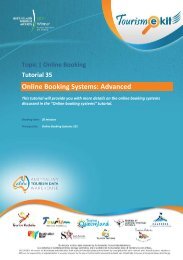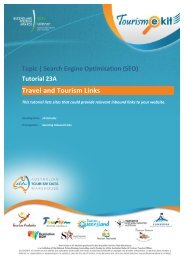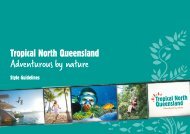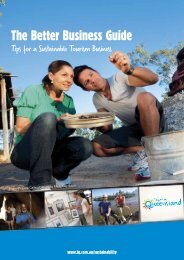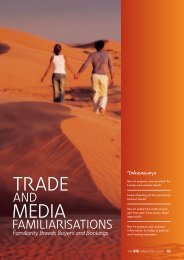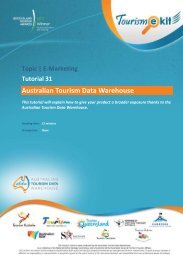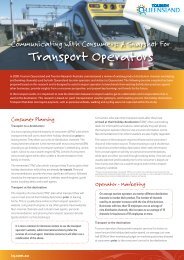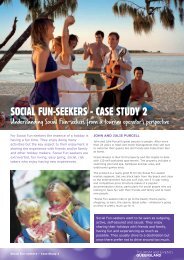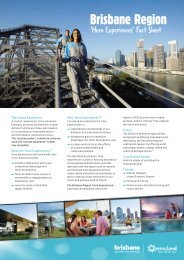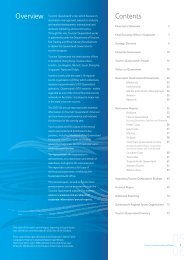Outback Education Handbook PDF - Tourism Queensland
Outback Education Handbook PDF - Tourism Queensland
Outback Education Handbook PDF - Tourism Queensland
Create successful ePaper yourself
Turn your PDF publications into a flip-book with our unique Google optimized e-Paper software.
24<br />
<strong>Outback</strong><br />
mining a shining example<br />
of a rich land<br />
Quirky fact :<br />
Did you know <strong>Queensland</strong> leads the world in the production<br />
of metallic minerals such as copper, lead and zinc?<br />
Curriculum Information<br />
Year<br />
Learning and Assessment (Place and Space)<br />
6 Mineral Wealth - Balancing the Future<br />
7 Mineral Resources Boom - A Global Responsibility<br />
Description<br />
<strong>Queensland</strong> is rich in mineral and energy resources such as coal, gold, lead, copper, zinc, silver, nickel, tin,<br />
bauxite, uranium, industrial minerals, oil and gas. The <strong>Outback</strong> region contains some of the world’s richest<br />
copper, lead, and zinc deposits and is home to one of the largest mineral producers Xstrata, Mount Isa Mines.<br />
<strong>Queensland</strong> Copper Mines<br />
Great Australia Mine - Cloncurry Copper<br />
Ernest Henry discovered copper in 1867 while outcropping near Cloncurry. Full of optimism, he named his<br />
discovery ‘Great Australia’. From 1906 copper prices boomed and Cloncurry flourished. The railway extended<br />
to the town to meet demand but in 1920 prices crashed and ‘Great Australia’ ceased operations. Ernest<br />
Henry is still considered the ‘father’ of Cloncurry and the old mine boasts remnants of its heyday including<br />
<strong>Queensland</strong>’s oldest water-jacket smelter casing and Cornish boilers.<br />
Ernest Henry Mine - Cloncurry Copper, Gold<br />
The Ernest Henry copper-gold mine began commercial production in 1998. The plant provides for up to 10<br />
million tonnes of ore to be extracted annually, to produce 100,000 tonnes of copper and 125,000 ounces of<br />
gold. Almost 3,500 people were involved in building the mine at a cost of $310 million and ensuing regional<br />
development has included a water pipeline, electricity transmission lines, conversion of Mica Creek Power<br />
Station to gas generation, a new airport terminal and improved air services.<br />
Mount Isa Mine - Copper Lead Zinc Silver<br />
Xstrata Mount Isa Mines (MIM) began with the discovery<br />
of lead-zinc outcrops by John Campbell Miles in 1923.<br />
By 1941, large reserves of copper were found at Black<br />
Star mine and copper was smelted from 1943. Within<br />
two decades, new copper smelters saw the annual<br />
copper yield of Black Rock grow to twice the combined<br />
production of all other Australian mines. MIM developed<br />
the ‘Isasmelt’ process in the 1980s, increasing the<br />
annual lead output by over 200,000 tonnes.<br />
Xstrata MIM is Australia’s largest underground mine and<br />
one of the world’s largest mining operations. It ranks<br />
in the top three producers of lead, top five producers<br />
of silver, 10th largest source of zinc and 19th largest<br />
producer of copper. Xstrata MIM includes Enterprise<br />
Mine, Australia’s most recent and deepest underground<br />
copper mine and George Fisher Mine, one of the<br />
largest undeveloped lead-zinc deposits in the world.<br />
Mount Isa<br />
062<br />
<strong>Queensland</strong>’s <strong>Outback</strong> <strong>Education</strong> <strong>Handbook</strong> | Natural <strong>Outback</strong>




